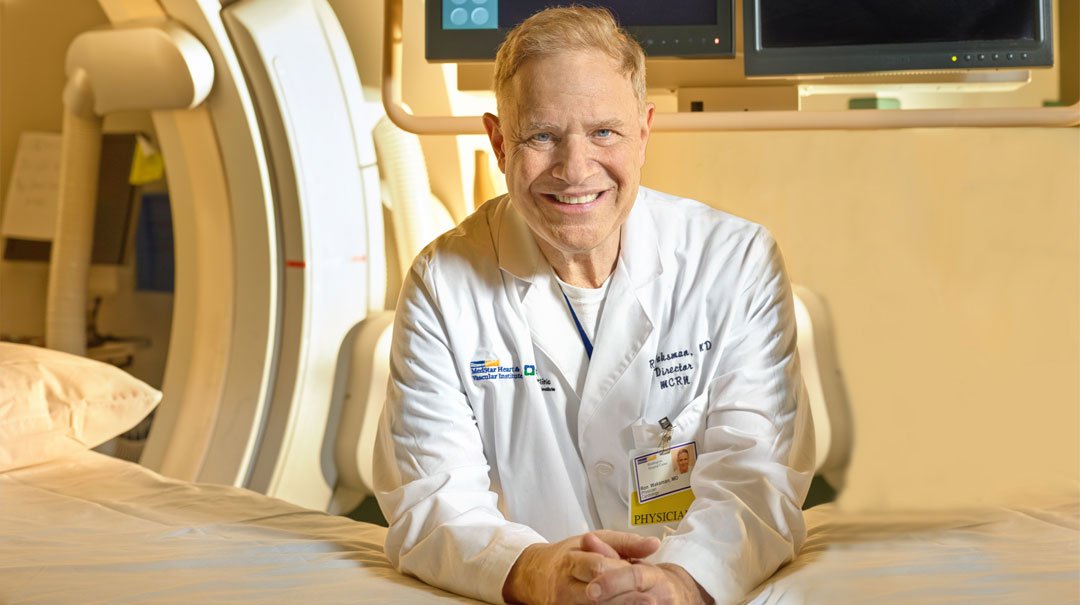Find care now
If you are experiencing a medical emergency, please call 911 or seek care at an emergency room.

The thin, delicate tissues of the valves in the human heart may be small—but they have a big job to do. They keep the blood flowing forward in your body. If they malfunction, they need to be repaired or replaced
At MedStar Heart & Vascular Institute, we are well equipped to restore optimal quality of life to patients requiring valve repairs or replacements. The good news for patients is that many of these procedures are minimally invasive, which means the patient can go home the following day.
The good news for patients is that many heart valve procedures are minimally invasive. https://bit.ly/2D2Zqia via @MedStarWHC #ValveDiseaseAwareness
Click to Tweet
One Heart, Four Valves
The human heart has four valves: the aortic, pulmonary, tricuspid, and mitral valve. Each can have its own problems, and each issue can manifest at a different age in patients. Some people are born with abnormal valves. Some develop malfunctioning valves through infection or as a result of aging.
How Does a Valve Malfunction?
Patients might experience two main issues with their valve, both involving the valve’s leaflets—thin flaps of tissue that open and close to allow blood flow.
- First, the valve can become leaky, which means that the leaflets are not closing and operating well and there is a leakage of blood. Instead of just flowing forward, the blood also moves backward
- Another problem is that the valves may develop stenosis, which is when the opening of the valve becomes narrowed and the leaflets don’t open enough. The result is that the ventricles, or lower chambers of the heart, don’t pump out enough blood
Symptoms Can Be Silent, Sudden, or Gradual
Symptoms of valve disease depend on the degree of the disease. Some people—those with a mitral valve prolapse, for example—might have no symptoms, or the symptoms may go away.
When something goes wrong with any of the valves, patients usually experience shortness of breath as well as weakness. The symptoms can be new to the patient—in other words, not previously experienced.
Because the onset of symptoms can be gradual rather than abrupt, the patient may not necessarily notice their symptoms. The intensity of symptoms depends on the cause and degree of the valve malfunction.
Patients with valve disease may also experience palpitations, a kind of fluttering of the heart. Some palpitations, especially involving the mitral valve, could spur atrial fibrillation, an irregularity of the heart rate. Occasionally, palpitations may also cause some chest discomfort or chest pain (this is most likely with mitral valve prolapse).
A Simple Test to Diagnose Valve Disease
It is very easy to diagnose problems of the heart valves or heart muscle with an echocardiogram—basically, an ultrasound of the heart. The ultrasound is a very simple procedure, not that costly, and is free of any risks or side effects. The results will give you an accurate answer to whether or not you have valve disease, and you can be diagnosed after one visit.
It’s important not to delay diagnosing valve disease. When the heart valves are not functioning properly, you may feel weak or have shortness of breath. The abnormal flow of blood may cause the heart muscle to start to behave differently.
Home of Pioneering Medical Advances
The team at MedStar Heart & Vascular Institute treats valve disease with an array of innovative, minimally invasive techniques, meaning we no longer have to perform traditional, open-heart surgery. Today, many patients can go home the next day with a repaired valve.
Some technologies were implemented at MedStar Heart & Vascular Institute before they were well known within the United States. For example, we were first in the country to use heart valves in patients diagnosed with severe aortic stenosis but who had a low risk of death.
We are now among the first to treat a mitral valve regurgitation with innovative technology started by some of our investigators, who also work at the National Institutes of Health. MedStar Heart & Vascular Institute can now offer this pioneering approach to its heart health patients.
Repair or Replacement?
Other than maintaining good dental health and living a clean lifestyle, there’s not much we can do to prevent heart valve disease. And once it occurs, it cannot be reversed. So, if a degenerative problem in the valve is diagnosed, it should be addressed, because it will not improve on its own.
If the existing valve can be repaired, we do so. Some cases are beyond repair—for example, when there is a severe narrowing of the valve. In a case like this, we have to replace them with a new valve.
A patient may be able to compensate for symptoms by using medication for some amount of time; however, this plan of care calls for the supervision of a cardiologist, as well as repeat ultrasounds of the heart to ensure no further deterioration of the valve conditions or the muscles.
Do Right by Your Valves
MedStar Heart & Vascular Institute, we’d like to underscore the critical importance of healthy heart valves.
Patients should be aware that valve disease can be easy to understand and easy to diagnose. And, in most cases, it’s not difficult to treat. Early diagnosis can help. A recommendation: at age 50, arrange to have an ultrasound of your heart—even if you don’t have obvious issues or symptoms.
If you do have to come see us, MedStar Heart & Vascular Institute is well equipped to help restore your valves. We have the capacity. We have the technology. We have the skills. We’ll do our best to bring you back to good health.














